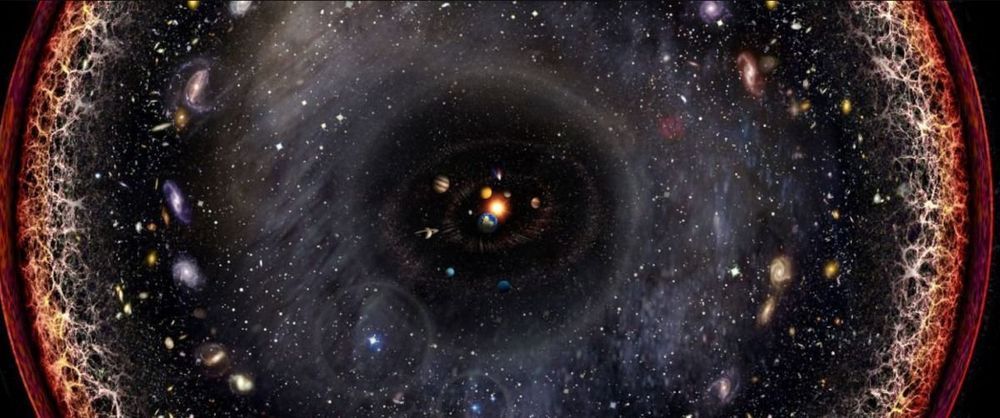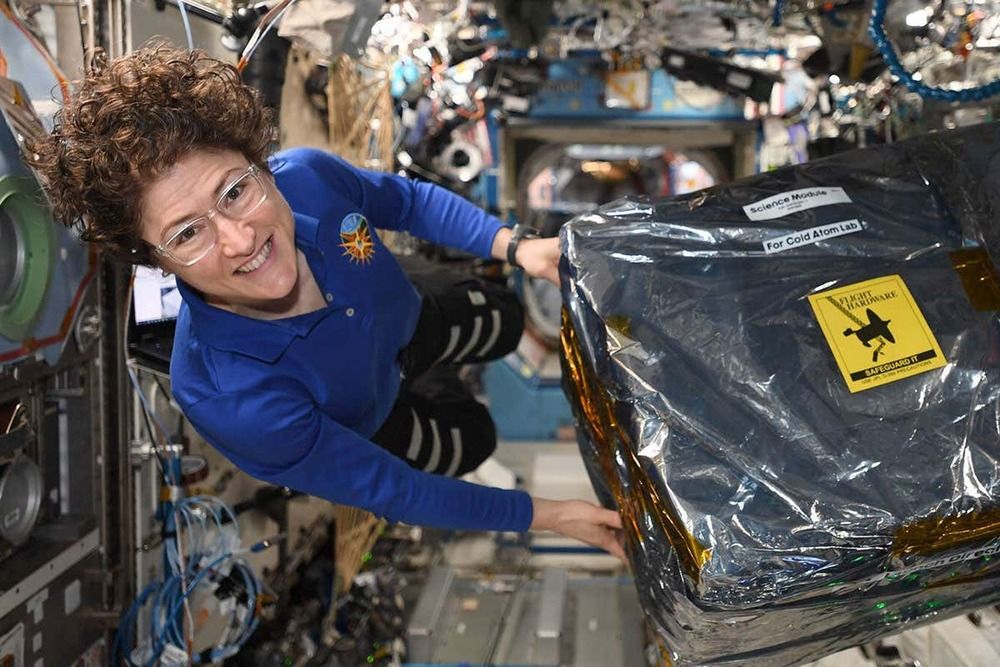An excess of events spotted in the XENON1T experiment could be signs of solar axions or weird, new properties of neutrinos, but not dark matter itself.



Circa 2014
Roughly 13.75 billion years ago, our universe came into existence. Very shortly thereafter, primordial light started shooting across the cosmos and spreading throughout the early universe. At this juncture, the universe itself was also expanding. The inflation of the universe slowed after the first initial burst, but since then, the rate of expansion has been steadily increasing due to the influence of dark energy.
Essentially, since its inception, the cosmos has been growing at an ever increasing rate. Cosmologists estimate that the oldest photons that we can observe have traveled a distance of 45–47 billion light-years since the Big Bang. That means that our observable universe is some 93 billion light-years wide (give or take a few light-years). These 93 some-odd billion light-years contain all of the quarks, quasars, stars, planets, nebulae, black holes…and everything else that we could possibly observe; however, the observable universe only contains the light that has had time to reach us.
How can the universe be 93 billion light-years across if it is only 13.8 billion years old? Light hasn’t had enough time to travel that far…? Ultimately, understanding this facet of physics is the key to understanding what lies beyond the edge of the observable universe and whether we could ever get there.
Researchers at Empa and EPFL have created one of the smallest motors ever made. It’s composed of just 16 atoms, and at that tiny size it seems to function right on the boundary between classical physics and the spooky quantum realm.
Like its macroscopic counterparts, this mini motor is made up of a moving part (the rotor) and a fixed part (the stator). The stator in this case is a cluster of six palladium atoms and six gallium atoms arranged in a rough triangular shape. Meanwhile, the rotor is a four-atom acetylene molecule, which rotates on the surface of the stator. The whole machine measures less than a nanometer wide.
The molecular motor can be powered by either thermal or electrical energy, although the latter was found to be much more useful. At room temperature, for example, the rotor was found to rotate back and forth at random. But when an electric current was applied using an electron scanning microscope, the rotor would spin in one direction with a 99-percent stability.

On September 10, 2008, CERN’s Large Hadron Collider (LHC) fired up for the very first time. In the decade since, the world’s largest and most powerful particle accelerator has been responsible for some of the most important breakthroughs in scientific history, most notably the discovery of the Higgs boson in 2013. New Atlas is celebrating the 10-year anniversary with a look back at the LHC’s achievements and, with a massive new upgrade in the works, what physics puzzles it could help piece together in the future.
Not only is the Large Hadron Collider the world’s largest particle accelerator, it’s the world’s largest machine, full-stop. That’s thanks to a 27-km-long (16.7-mi) ring of pipes that house the particle beams, along with thousands of powerful magnets and an advanced cooling system of liquid helium.
The ring is made up of two separate tubes, with high-energy particle beams circling in opposite directions. Superconducting electromagnets accelerate the particles almost to the speed of light, and for those to work they need to be kept extremely cold: −271.3° C (−456.3° F) to be exact, which is colder than outer space. That’s where the liquid helium comes in, chosen because it’s the only known element to remain in a liquid form at such low temperatures.
A research team from Empa and EPFL has developed a molecular motor which consists of only 16 atoms and rotates reliably in one direction. It could allow energy harvesting at the atomic level. The special feature of the motor is that it moves exactly at the boundary between classical motion and quantum tunneling — and has revealed puzzling phenomena to researchers in the quantum realm.
The smallest motor in the world—consisting of just 16 atoms: this was developed by a team of researchers from Empa and EPFL. “This brings us close to the ultimate size limit for molecular motors,” explains Oliver Gröning, head of the Functional Surfaces Research Group at Empa. The motor measures less than one nanometer—in other words it is around 100,000 times smaller than the diameter of a human hair.
In principle, a molecular machine functions in a similar way to its counterpart in the macro world: it converts energy into a directed movement. Such molecular motors also exist in nature—for example in the form of myosins. Myosins are motor proteins that play an important role in living organisms in the contraction of muscles and the transport of other molecules between cells.

The cosmos contains a Higgs field—similar to an electric field—generated by Higgs bosons in the vacuum. Particles interact with the field to gain energy and, through Albert Einstein’s iconic equation, E=mc2, mass. The Standard Model of particle physics, although successful at describing elementary particles and their interactions at low energies, does not include a viable and hotly debated dark-matter particle. The only possible candidates, neutrinos, do not have the right properties to explain the observed dark matter.
“One particularly interesting possibility is that these long-lived dark particles are coupled to the Higgs boson in some fashion—that the Higgs is actually a portal to the dark world. We know for sure there’s a dark world, and there’s more energy in it than there is in ours. It’s possible that the Higgs could actually decay into these long-lived particles,” said LianTao Wang, a University of Chicago physicist, in 2019, referring to the last holdout particle in physicists’ grand theory of how the universe works, discovered at the LHC in 2012, filling the last gap in the standard model of fundamental particles and forces. Since then, the standard model has stood up to every test, yielding no hints of new physics.
The dark world makes up more than 95 percent of the universe, but scientists only know it exists from its effects—” like a poltergeist you can only see when it pushes something off a shelf.” We know there’s dark matter because like the poltergeist, we can see gravity acting on it keeping galaxies from flying apart.

A similar glow is sometimes seen by astronauts on the space station when they look to the Earth’s limb.
The glow comes from oxygen atoms when they’re excited by sunlight.
The phenomenon has long been predicted to occur on other planets, but the Trace Gas Orbiter (TGO) — a joint European-Russian satellite at Mars — is the first to make the observation beyond Earth.

The European Space Agency (ESA) has just announced that its ExoMars Trace Gas Orbiter (TGO) has identified a long-suspected “green glow” around Mars. The green glow is due to the interaction of sunlight with atoms and molecules in Mars’ atmosphere. To date, we’ve only observed the phenomenon around one other planet: Earth. Now, the scientists who’ve discovered the Red Planet’s green glow say it could help us better understand the planet’s atmosphere. And how to land safely on its surface.
Futurism reported on the finding, which was outlined in a paper recently published in the journal, Nature. According to the paper, this discovery marks the first time scientists have observed the “day glow” and “night glow” that generate the “green line” around Earth around Mars. Or any other planet. The discovery also stands as long sought-after confirmatory evidence of predictions regarding the Martian atmosphere, which date back 40 years.
The world’s largest atom smasher has “given birth” to a set of four ultraheavy particles — called top quarks.
The formation of these chubby-but-tiny quadruplets, at the Large Hadron Collider in Geneva, Switzerland, has long been predicted by the Standard Model, the prevailing physics theory that governs subatomic interactions. But new physics theories suggest they could be created much more often than the Standard Model predicts. Finding more of such foursomes is the first step in testing those theories. The new findings were announced at the LHCP 2020 Conference.
